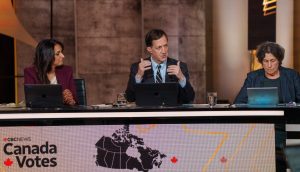According to the latest numbers released by Canadian Broadcast Sales yesterday, national radio sales climbed 9.5% in Q1, and are on track to post strong annual growth of 8.7%.
‘We were almost 50% ahead of our Q1 pacing of only 90 days ago,’ explains CBS president Patrick Grierson. ‘We’re showing strength across the board with resultant pressure on inventory, which leads to minimum unit rates,’ he adds. ‘Saskatchewan was up 45%, Manitoba 36%, Alberta 9%, while Atlantic Canada was 8% ahead of last year. Ontario was up 18.9% with Toronto plus 14.3%.’
In Grierson’s estimation, ‘The television writers’ strike could have a positive impact on radio in Q2 and Q3 if it remains unresolved. Because of the growing recognition of radio’s strength as a reach medium, we believe that radio’s future growth will come from television as audiences become more fragmented.’
CBS says the top five spending categories accounted for 56.8% of total dollars. Retail led the way with 17.9%, while telecommunications accounted for 11.7%, financial services & insurance was 9.3% and government 7.7% (due largely to the Ontario election). National automotive was down to 10.19% from 15.6%.
‘Automotive declined despite a stronger performance by General Motors. Q1 saw a shift of spending to local dealers by other manufacturers,’ Grierson notes. ‘Other categories like telecommunications stepped up to fill the automotive void.’
In select markets, including Calgary and Edmonton, local unit rates are now consistently higher than national rates, as local revenue growth has been pacing over three times faster than national so far this year. ‘This situation is being driven by strong local growth putting pressure on inventories,’ says Grierson. ‘National buys are driven by ratings, while local buys are driven by results. The best way for advertisers to deal with this demand,’ he adds, ‘is to commit their budgets as early as possible. It would also be wise to plan for increased costs in Alberta, as is now the norm for that province’s economy.’
Q1 spending by demographic remained stable with Adults 25-54 accounting for 60% of all dollars spent. Adults 18-49 accounted for 8.64% of spending.






















